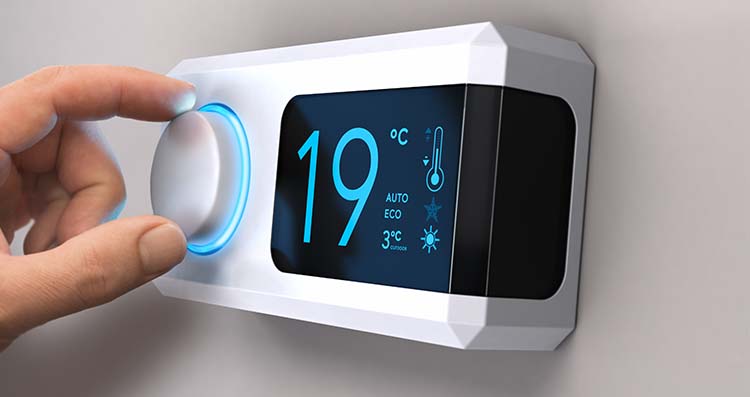The office at 19 degrees: how does it affect comfort levels and productivity?
Energy prices have soared in recent months, and the ecological crisis continues unabated. So, the clear message is that we must become more economical with energy consumption. This applies at home as well as in the workplace. The new norm in office and government buildings is 19 degrees. One to two degrees less than before. The difference seems small, but how does it affect our comfort, health and productivity?
Until recently, the average office temperature was 20 to 21 degrees. At the same time, research shows that employees are most productive at 22 degrees. Because that is when their perceived thermal comfort is highest. So setting the thermostat to double ‘2’ was considered ideal. Or is it? Some colleagues weigh the pros and cons from their specific backgrounds.

The new norm in office and government buildings is 19 degrees. Colleagues Gerrit Pollentier, Rosi Vander Elst and Michelle D'Haese weigh the pros and cons from their specific backgrounds.
An ideal indoor temperature: is it even real?
Gerrit Pollentier, Ergonomics Manager: ‘The office temperature is not the only factor that affects employees’ thermal comfort. A person’s metabolism and level of activity also play an important role. Is the heating set at 22 degrees? Then employees experience a high level of comfort without having to move a lot. Believing that this temperature is ‘ideal’ is a risky assumption. Because random sedentary behaviour poses serious health risks.’
Rosi Vander Elst, Environment Manager: ’Besides, there isn’t just one “ideal” temperature. For instance, women tend to feel cold faster than men, older employees prefer higher temperatures, and the room feels warmer for those sitting near the heater or by the window. So a specific temperature will never satisfy everyone. So, you should try to find the golden mean.’ You can discover it with these useful tips:
- Adjust the temperature gradually. Turn down the heating by half a degree gradually over a long period, so your staff can get used to the new temperatures. Inform them about the changes in advance so they can dress in layers.
- If possible, provide warmer rooms. Many offices seem to have adopted 19 degrees as the new norm. Nevertheless, some colleagues will occasionally need a warmer environment. Offering hot drinks also helps increase the feeling of comfort.
- Provide adequate ventilation. It may sound counter-intuitive, but adequate ventilation is important even in cold outdoor temperatures. It lets in dry air that warms up more easily than humid indoor air.
- Ensure proper basic maintenance of appliances occurs. A stable office temperature requires well-maintained appliances that are in the right places. This generates more thermal comfort and reduces energy consumption.

Use energy-efficient cooling systems
An energy audit of your air-conditioning is the first step towards the energy-efficient use of your cooling system. That audit is mandatory for systems with a rated cooling capacity of 12 kW or more. For more info, contact our experts. You are welcome to contact us via milieu@mensura.be.
Is 19 degrees an achievable and healthy standard?
Michelle D’Haese, Industrial Hygiene and Toxicology Manager: ‘Belgian legislation sets action values for healthy temperatures in workplaces. For example, a minimum temperature of 18 degrees applies in the office. So, 19 degrees as the new standard is nicely in line with the regulations.’
Gerrit: ‘A touch of cold can also encourage staff to move around more. This minor action will make a big difference to staff’s physical and mental well-being. Walking while talking on the phone, stretching their legs for a while or dynamic working reduces the risk of staff having back and neck pain, helps their metabolism get out of standby mode over time and prevents dips in energy. This has a positive effect on productivity.’
Michelle: ‘Getting some fresh air during your lunch break can also do wonders. Half an hour of exercise, airing your lungs and head for a bit and then coming back in at 18 or 19 degrees both figuratively and literally gives you a warm feeling for continuing your workday.’

Promote the well-being on employee screens
Staff working in front of a screen spend most of their time seated, which makes them susceptible to certain health problems. You can use the updated e-Survey VDU Work to gauge such potential hazards and lay the groundwork for specific actions to promote staff well-being.
And what about when working from home?
Rosi: ‘At home, you are in charge of the thermostat. Still, a temperature of 19 degrees can encourage staff to move just a little bit more even when working from home. And, of course, proper maintenance of heating appliances is positive in that it reduces your energy bills.
It is still important that you have sufficient ventilation. Humidity increases in the house on cold days. Dry outside air is the ideal countermeasure. It ensures proper indoor air quality, including low amounts of accumulated viruses (such as COVID-19) and a low CO2 concentration. In a nutshell, you win on all fronts.’
A healthy indoor climate for healthy staff
A healthy indoor climate is essential for staff comfort and productivity. You can map out the climate situation in your organisation with a focused risk analysis. Our experts will be happy to help you with this.
You are welcome to contact us through the form below.